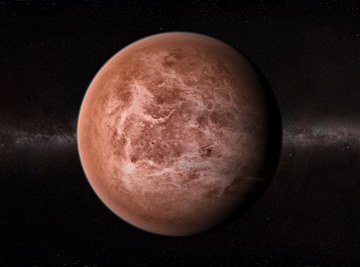
As of 2018, the solar system included one very large sun, eight planets, five dwarf planets, about 150 moons and an assortment of other small objects. Older sources will assure you that the solar system has nine planets, as this was technically the official scientific position from 1930, when Pluto was discovered, until 2006, when it was "downgraded" to dwarf-planet status. What this reveals more than anything else is not that scientists are in the habit of waffling, but that astronomy is a rich and dynamic field in which a number of major new discoveries are made every year, especially with humankind having put super-powerful telescopes like the Hubble into space.
The notion of exploring other planets, not "just" with astronaut-free spacecraft but by sending human beings there, has slowly moved from a science-fiction fantasy into a realm that, while not precisely imminent, is a genuine consideration. It's therefore natural to wonder what planet would be ideal to visit if humankind only got one shot. In short, the closest planet to Earth may not be the wisest choice.
The Solar System and Planets
The solar system includes the sun and everything that revolves around it under the influence of gravity, primarily planets, moons, comets, asteroids and meteoroids. The eight planets are divided into four smaller, inner terrestrial planets (so named because they are Earth-like in being entirely solid) and four larger, outer gas giants (made mostly of methane but possessing a core of metal and rock. From innermost to outermost, the planets are Mercury, Venus, Earth, Mars, Jupiter, Saturn, Uranus and Neptune. Pluto, the dwarf planet, has an orbit that lies considerably outside that of Neptune most of the time. Conveniently for memorization purposes, the asteroid belt, home to over 780,000 individual asteroids (rocky, irregular bodies too small to be called planets), lies between Mars and Jupiter, thereby serving as an informal barrier between the four small planets and the four large ones.
It is critical to note that the distances between planets becomes greater with increasing distance from the sun. Viewed from above and with the orbits of each planet made magically visible, the solar system would not resemble a series of evenly spaced concentric rings. Instead, you would see that the distance from the sun to Mars, the most remote of the terrestrial worlds, is only about 1/20th of the distance from the sun to Neptune. In fact, Saturn is almost twice as far from the sun as Jupiter is, and Uranus in turn is nearly twice as far from the sun as Saturn. What this implies is that when considering distances from Earth to its planetary neighbors, moving from one to the next is not like walking along a city street and encountering a series of regularly spaced intersections. Instead, it's more like walking for a few minutes to reach one waypoint, then for an hour to get to the next and then for many hours, even days, before coming to another.
Venus: The Nearest Planet to Earth
When you again imagine the solar system from above as a dynamic entity, picture every planet revolving around the sun, with the innermost ones taking far less time to complete a single circuit than those outside it, just as your intuition probably leads you to suspect. Mercury's year is only 88 Earth days, while that of Venus is 225 days. This means that it is rare for Mercury, Venus and Earth to all lie in a straight line from the sun outward. At times, the sun is directly between Earth and other planets.
Venus is the closest planet to Earth under most circumstances. Venus orbits the sun at a distance of about 67 million miles, while the Earth orbits at about 93 million miles. From basic geometry, then, when the two planets are at their closest, which occurs when Venus is right between the sun and the Earth, the two planets are about 26 million miles apart – a situation that occurs every 584 days. When Venus and Earth are on precisely opposite sides of the sun, the distance between them is 160 million miles (93 million plus 67 million). At these times, Mercury, orbiting at a distance of roughly 33 million miles, is actually closer to Earth than Venus is.
As a planet, Venus (named, incidentally, for the Roman goddess of love; the Greek counterpart is Aphrodite) is similar to the Earth in its proportions. Its diameter is 95 percent of Earth's, and its density is 90 percent of Earth's, making its mass 81 percent of Earth's. Its atmosphere, however, is radically different. It consists overwhelmingly of carbon dioxide (CO2), much like the Earth's did at a distant point in geological history. As you have surely heard, CO2 is a greenhouse gas and traps heat very effectively. This, combined with Venus's being so close to the sun, results in temperatures of close to 900° F (475° C). Venus is essentially a giant furnace, and primarily for this reason, Earth scientists long ago relinquished the idea that Venus might host anything living. This has not discouraged remote exploration of the planet, as you'll learn below.
Mars: The Red Planet
Mars is Earth's other "next-door" neighbor, being next in the planetary line. Mars' average distance from the sun is 131 million miles. (The reason planetary orbit sizes are given as averages is that these orbits are not circular but elliptical, with the degree of deviation from circular varying from planet to planet.) At their closest, Earth and Mars are about 36 million miles apart. This was the case in July 2018, resulting in a very good year overall for fans of "the Red Planet," which appeared to be unusually bright throughout the summer, and in fact for the whole year.
Mars, despite its typically being much farther from Earth than Venus, has been a more intense object of scrutiny among astronomers and fans of science fiction alike, because its other qualities lend itself to at least the remote possibility that life could exist there. So far, however, the scientific consensus is that life as humans know it is really no more likely on Mars than it is on Venus.
Exploration of Venus
Owing to the formidable climatic conditions on Venus, simply getting a probe to land on the surface has been very difficult; most of the imaging of its terrain has been accomplished through the use of radar.
In the 1960s, the Soviet Union began sending a series of spacecraft under its Venera program to Venus. One of them struck the surface in 1966. While a crash-landing may not sound romantic, this was the first time a human-made object had contacted another planet's surface. By the time Venera was closed down in 1983, its probes had managed to transmit a great deal of useful data about the planet back to Earth. The U.S., meanwhile, operated its Mariner program from 1962 to 1974, doing a series of fly-bys but no landings.
NASA launched a craft called Magellan in 1989, and in the next five years it used radar to map about 98 percent of the Venusian surface. In 2006, the European Space Agency got in on the action with its Venus Express, which conducted a detailed analysis of the atmosphere and found that Venus, like Earth, has an ozone layer.
References
About the Author
Kevin Beck holds a bachelor's degree in physics with minors in math and chemistry from the University of Vermont. Formerly with ScienceBlogs.com and the editor of "Run Strong," he has written for Runner's World, Men's Fitness, Competitor, and a variety of other publications. More about Kevin and links to his professional work can be found at www.kemibe.com.
